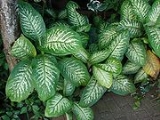
Dieffenbachia seguine
Encyclopedia
Dieffenbachia seguine is a species of Dieffenbachia
native to the tropical Americas
—from Southern Mexico, through Central America
, to northern South America
and Brazil
. It is also native
to several Caribbean
islands, including Puerto Rico
.
Description
The herbaceous perennial grows 3 to 10 feet in height and 2 to 3 feet in width . The plant's leaves are large and green, and often with variegated white patterns. Like other Dieffenbachias, the sap is toxic. It has showy white flowers .
Cultivation
Dieffenbachia seguine is cultivated as an ornamental plant
in temperate shade garden
s and as a potted house plant . Cultivar
s emphasize different patterns of variegation.
Dieffenbachia
Dieffenbachia is a genus of tropical plants in the Family Araceae noted for their patterned leaves. Members of this genus are popular as houseplants because of their tolerance for shade. The common name is "dumb cane" due to its poisoning effect on the throat due to raphides...
native to the tropical Americas
Americas
The Americas, or America , are lands in the Western hemisphere, also known as the New World. In English, the plural form the Americas is often used to refer to the landmasses of North America and South America with their associated islands and regions, while the singular form America is primarily...
—from Southern Mexico, through Central America
Central America
Central America is the central geographic region of the Americas. It is the southernmost, isthmian portion of the North American continent, which connects with South America on the southeast. When considered part of the unified continental model, it is considered a subcontinent...
, to northern South America
South America
South America is a continent situated in the Western Hemisphere, mostly in the Southern Hemisphere, with a relatively small portion in the Northern Hemisphere. The continent is also considered a subcontinent of the Americas. It is bordered on the west by the Pacific Ocean and on the north and east...
and Brazil
Brazil
Brazil , officially the Federative Republic of Brazil , is the largest country in South America. It is the world's fifth largest country, both by geographical area and by population with over 192 million people...
. It is also native
Native plant
Native plant is a term to describe plants endemic or naturalized to a given area in geologic time.This includes plants that have developed, occur naturally, or existed for many years in an area...
to several Caribbean
Caribbean
The Caribbean is a crescent-shaped group of islands more than 2,000 miles long separating the Gulf of Mexico and the Caribbean Sea, to the west and south, from the Atlantic Ocean, to the east and north...
islands, including Puerto Rico
Puerto Rico
Puerto Rico , officially the Commonwealth of Puerto Rico , is an unincorporated territory of the United States, located in the northeastern Caribbean, east of the Dominican Republic and west of both the United States Virgin Islands and the British Virgin Islands.Puerto Rico comprises an...
.
Description
The herbaceous perennial grows 3 to 10 feet in height and 2 to 3 feet in width . The plant's leaves are large and green, and often with variegated white patterns. Like other Dieffenbachias, the sap is toxic. It has showy white flowers .
Cultivation
Dieffenbachia seguine is cultivated as an ornamental plant
Ornamental plant
Ornamental plants are plants that are grown for decorative purposes in gardens and landscape design projects, as house plants, for cut flowers and specimen display...
in temperate shade garden
Shade garden
Shade gardens are gardens planted and grown in areas with little or no direct sunlight during the day, either under trees or on the shady sides of buildings. Shade gardening presents certain challenges, in part because only certain plants are able to grow in shady conditions. Very few edible plants...
s and as a potted house plant . Cultivar
Cultivar
A cultivar'Cultivar has two meanings as explained under Formal definition. When used in reference to a taxon, the word does not apply to an individual plant but to all those plants sharing the unique characteristics that define the cultivar. is a plant or group of plants selected for desirable...
s emphasize different patterns of variegation.

